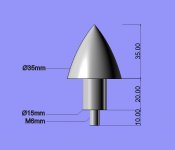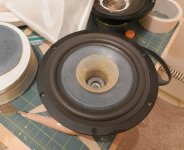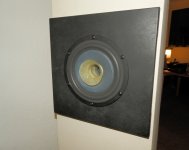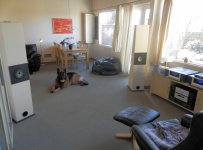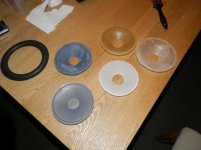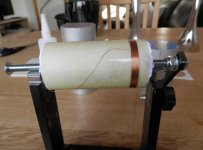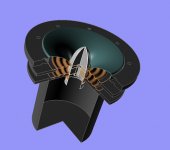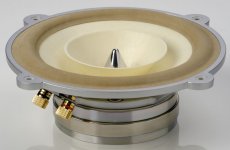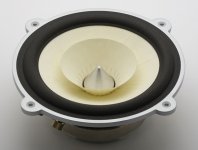David saw your post and i took some pictures of the PUMA 400
Would love to see a pic of your Valliere when its all setup.
Finally, a phone photo.
http://www.diyaudio.com/forums/attachment.php?attachmentid=336806&stc=1&d=1363595516
Best wishes
David
Altered oversize picture to a link to save a download for the uninterested.
Last edited:
This better?hmm not working for me David,
i get "Invalid Attachment specified."
Best wishes
David
Hello,
Happing Easter for those celebrating, hope the small vacation meant time for building things audio.
I have been busy building a pair of field coil motors for our colleague Frank.
He is pursuing his fiberglass cone development, and i hope he will write more about it as it is very interesting and helpful for DIY community.
Motors will be for a 6.5" unit so diameter is 124mm. Here are some pictures of field coil, pole pieces and phase plugs. Frank had an interesting idea about phase plugs, maybe he will share if he wants to.
The above picture is the top plate, designed to nicely saturate just the gap so that it will be less prone to modulation.
Will be complete soon and then Frank can compare magnets vs field coils
On another side, I've basically finished TEA, temperature effect analysis tool. Just needs a minor calibration. It can measure field coil resistance over time, voice coil resistance over time, system temp and calculates temp coef for voice coil to be then used to determine power compression and the like. Data can be exported as image or csv file for archiving or further processing.
Here is a 30 min run on the field coil for the 12 incher and some shots of the tool and such.
So busy days here, but i will get back on the 12 incher soon. I have prepared for a test session which i expect to reveal some important technical aspects.
Happing Easter for those celebrating, hope the small vacation meant time for building things audio.
I have been busy building a pair of field coil motors for our colleague Frank.
He is pursuing his fiberglass cone development, and i hope he will write more about it as it is very interesting and helpful for DIY community.
Motors will be for a 6.5" unit so diameter is 124mm. Here are some pictures of field coil, pole pieces and phase plugs. Frank had an interesting idea about phase plugs, maybe he will share if he wants to.
An externally hosted image should be here but it was not working when we last tested it.
An externally hosted image should be here but it was not working when we last tested it.
An externally hosted image should be here but it was not working when we last tested it.
An externally hosted image should be here but it was not working when we last tested it.
An externally hosted image should be here but it was not working when we last tested it.
An externally hosted image should be here but it was not working when we last tested it.
An externally hosted image should be here but it was not working when we last tested it.
An externally hosted image should be here but it was not working when we last tested it.
An externally hosted image should be here but it was not working when we last tested it.
The above picture is the top plate, designed to nicely saturate just the gap so that it will be less prone to modulation.
An externally hosted image should be here but it was not working when we last tested it.
Will be complete soon and then Frank can compare magnets vs field coils
On another side, I've basically finished TEA, temperature effect analysis tool. Just needs a minor calibration. It can measure field coil resistance over time, voice coil resistance over time, system temp and calculates temp coef for voice coil to be then used to determine power compression and the like. Data can be exported as image or csv file for archiving or further processing.
Here is a 30 min run on the field coil for the 12 incher and some shots of the tool and such.
An externally hosted image should be here but it was not working when we last tested it.
An externally hosted image should be here but it was not working when we last tested it.
An externally hosted image should be here but it was not working when we last tested it.
An externally hosted image should be here but it was not working when we last tested it.
An externally hosted image should be here but it was not working when we last tested it.
So busy days here, but i will get back on the 12 incher soon. I have prepared for a test session which i expect to reveal some important technical aspects.
Hi all
Fist I will like to say....I am relay looking forward to receive my new motors, you have done an excellent job Hentai.
I have done some experiments on cone material and I found two that I like very much. The first one is fibre glass it is very stiff and light and has a good energy conductivity at high frequency, perfect for wizzer's. The second one is viscose cloth treated with resin/epoxy, it is not as stiff as fibre glass but is has a high degree of self damping and I use it as the main cone for now.
I need to make a new experiment with a wizzer that is made of both fibre glass and viscose cloth, to see how the wizzer works with a higher degree of damping.
The idea for the phase plug the Hentai mention, is to minimize the air tubules and resonances between the coil form and the phase plug it self. The solution is simple, the phase plug is designed so there is room for some damping material. See pic.
I did some funny math to see what it is we like our speaker to do, and to say the lest I was surprised. I was looking to how small movements the speaker is requite to do... If you stayed a cone is moving +/- 1mm at 20Hz the movement is just 1 micro meter at 20KHz and given you have a dynamic range of 90-100 dB you can see the movement is less that most light waves!!!!!!!
This gives a good indication that all flexing in the material and glues we use, must be taken to account.
I have posted some pic's of some of my work, please fell free to comment.
Take care
Frank
Fist I will like to say....I am relay looking forward to receive my new motors, you have done an excellent job Hentai.
I have done some experiments on cone material and I found two that I like very much. The first one is fibre glass it is very stiff and light and has a good energy conductivity at high frequency, perfect for wizzer's. The second one is viscose cloth treated with resin/epoxy, it is not as stiff as fibre glass but is has a high degree of self damping and I use it as the main cone for now.
I need to make a new experiment with a wizzer that is made of both fibre glass and viscose cloth, to see how the wizzer works with a higher degree of damping.
The idea for the phase plug the Hentai mention, is to minimize the air tubules and resonances between the coil form and the phase plug it self. The solution is simple, the phase plug is designed so there is room for some damping material. See pic.
I did some funny math to see what it is we like our speaker to do, and to say the lest I was surprised. I was looking to how small movements the speaker is requite to do... If you stayed a cone is moving +/- 1mm at 20Hz the movement is just 1 micro meter at 20KHz and given you have a dynamic range of 90-100 dB you can see the movement is less that most light waves!!!!!!!
This gives a good indication that all flexing in the material and glues we use, must be taken to account.
I have posted some pic's of some of my work, please fell free to comment.
Take care
Frank
Attachments
Last edited:
Quote; "If you stayed a cone is moving +/- 1mm at 20Hz the movement is just 1 micro meter at 20KHz and given you have a dynamic range of 90-100 dB you can see the movement is less that most light waves"
One way to see the standing waves on the cone material is to use Moire diffraction where white light is differentially diffracted into component colours (wave lengths) in proportion to the vertical height of the cone perturbation. Longer wave lengths indicating greater perturbation height (or is it the other way around?).
Focus is achieved by varying the distance between the Moire grid and observation point (camera or naked eye).
A Moire grid can be easily made by printing black stripes on clear film using your laser printer. The challenge is to determine the grid dimensions for the subject size and perturbation height (see any physics 201 text because I do not remember).
And many thanks for a very stimulating and interesting thread, I really admire the art and engineering that you and Hentai and others are putting into this. Please do not stop sharing your journey.
John
One way to see the standing waves on the cone material is to use Moire diffraction where white light is differentially diffracted into component colours (wave lengths) in proportion to the vertical height of the cone perturbation. Longer wave lengths indicating greater perturbation height (or is it the other way around?).
Focus is achieved by varying the distance between the Moire grid and observation point (camera or naked eye).
A Moire grid can be easily made by printing black stripes on clear film using your laser printer. The challenge is to determine the grid dimensions for the subject size and perturbation height (see any physics 201 text because I do not remember).
And many thanks for a very stimulating and interesting thread, I really admire the art and engineering that you and Hentai and others are putting into this. Please do not stop sharing your journey.
John
Why not a leather surround like oldschool and Rullits FR?
I can only speak for my self, but I have three reasons. One is leather is not a light material, second I have no idea how to make a leather surrounding.... But I think my unit will end up without any surroundings at all. I would think it will end up looking something like the picture.
Take care
Frank
Attachments
I can only speak for my self, but I have three reasons. One is leather is not a light material, second I have no idea how to make a leather surrounding.... But I think my unit will end up without any surroundings at all. I would think it will end up looking something like the picture.
Take care
Frank
Interesting design.
But makes one wonder, how would you guarantee an airtight fit between the cone and the surround without having any friction or "stiction" between cone and surround? Such a design would call for extremely tight tolerances and even then, I'm not sure how airtight the fit would be.
I can only speak for my self, but I have three reasons. One is leather is not a light material, second I have no idea how to make a leather surrounding.... But I think my unit will end up without any surroundings at all. I would think it will end up looking something like the picture.
Take care
Frank
This is exactly what i am trying to build. But also without the spider. No resonance freq. from the surround and spider. Non lineairity compensation with em suspension, designed till p-p 8mm. I am affraid for the break up nodes of the cone withoud surrounding. I read your findings and these from hentai with great interest, a lot of things are interesting. Question: 4.5gr extra mass (second coil) for extra 10Tm till a total of 20Tm. better or not better for higher freq output due to higher mass? Re drops from 6.5 to 3.2ohm in parallel
For now cone is too heavy i think (20gr). for mid-bass? Hopefully the high flux density would compensate, not sure.
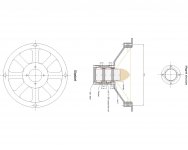


cheers
Last edited:
Very interesting Jef.
Extra mass is always bad high frequency. Increased BL will give you a bell shaped response between 1khz-4khz as i noticed. You also gain on efficiency with the lower Re so all in all it might be worth while. High flux can compensate high mass but not on the entire bandwidth. Being in parallel the second inductance shouldn't cause much problems.
There is also an aspect regarding cone mass and voice coil mass. There are some effects going on in the 3 cases when one is bigger than the other and when they are equal. If cone is much heavier than voice coil a small mass added by the extra coil will be negligible compared to the BL boost.
Extra mass is always bad high frequency. Increased BL will give you a bell shaped response between 1khz-4khz as i noticed. You also gain on efficiency with the lower Re so all in all it might be worth while. High flux can compensate high mass but not on the entire bandwidth. Being in parallel the second inductance shouldn't cause much problems.
There is also an aspect regarding cone mass and voice coil mass. There are some effects going on in the 3 cases when one is bigger than the other and when they are equal. If cone is much heavier than voice coil a small mass added by the extra coil will be negligible compared to the BL boost.
Goat Leather.
The Voxativ AC-3B is a very well constructed, very expensive 8" full'ish range speaker from Germany.
The suspension material is now a very fine goat leather. As a natural substance it has much better acoustic properties in comparison to foam or rubber. It reduces the internal friction considerably so that the saved energy is now fully transformed in cone movement and impulse reproduction.
---------
Voxativ also offers several foam surround suspension material speakers. Several different motors using NdFeB disks, NdFeB radials, and ceramic disk materials are available.
-----------
Wide bandwidth 8" speakers can cover the 80-1100Hz vocal range with modest challenges in beaming and Center-to-Center lobing at the crossover. I think phase plugs mainly make sense on 7" to 10" midbass speakers to slightly extend the usable frequency range for a smooth tweeter Xover.
The Voxativ AC-3B is a very well constructed, very expensive 8" full'ish range speaker from Germany.
The suspension material is now a very fine goat leather. As a natural substance it has much better acoustic properties in comparison to foam or rubber. It reduces the internal friction considerably so that the saved energy is now fully transformed in cone movement and impulse reproduction.
---------
Voxativ also offers several foam surround suspension material speakers. Several different motors using NdFeB disks, NdFeB radials, and ceramic disk materials are available.
-----------
Wide bandwidth 8" speakers can cover the 80-1100Hz vocal range with modest challenges in beaming and Center-to-Center lobing at the crossover. I think phase plugs mainly make sense on 7" to 10" midbass speakers to slightly extend the usable frequency range for a smooth tweeter Xover.
Attachments
Hello all.
Just a thought: has a surround of cloth been given serious consideration? The characteristics of behavior in a cloth surround could be easily adjusted to suit the application by the implementation of various treatments of whatever impregnations or surface coatings (on the one hand). In the other hand, there are the endless options of fibers to choose from, both natural and manufactured. If I dare give a specific recommendation for your consideration regarding the choice of fiber, it would be silk: thin, lightweight, incredibly strong, incredibly fatigue resistant, easy enough to impregnate to suit whatever desired damping characteristics (and would still be light), and also would exhibit a low friction through excursion.
Regards - Aubrey
Just a thought: has a surround of cloth been given serious consideration? The characteristics of behavior in a cloth surround could be easily adjusted to suit the application by the implementation of various treatments of whatever impregnations or surface coatings (on the one hand). In the other hand, there are the endless options of fibers to choose from, both natural and manufactured. If I dare give a specific recommendation for your consideration regarding the choice of fiber, it would be silk: thin, lightweight, incredibly strong, incredibly fatigue resistant, easy enough to impregnate to suit whatever desired damping characteristics (and would still be light), and also would exhibit a low friction through excursion.
Regards - Aubrey
- Home
- Loudspeakers
- Multi-Way
- Project Ryu - DIY Field Coil Loudspeaker
